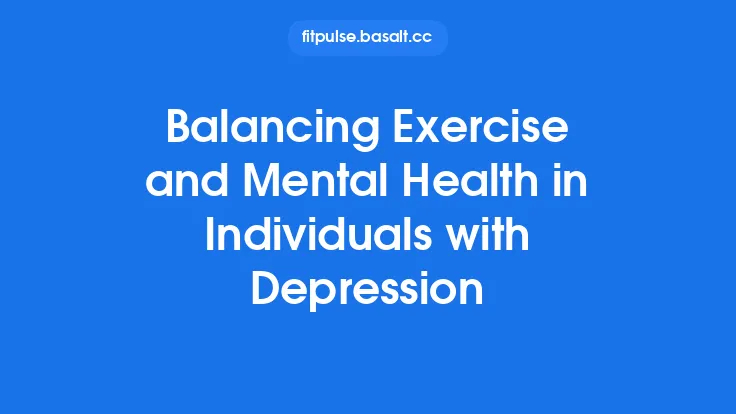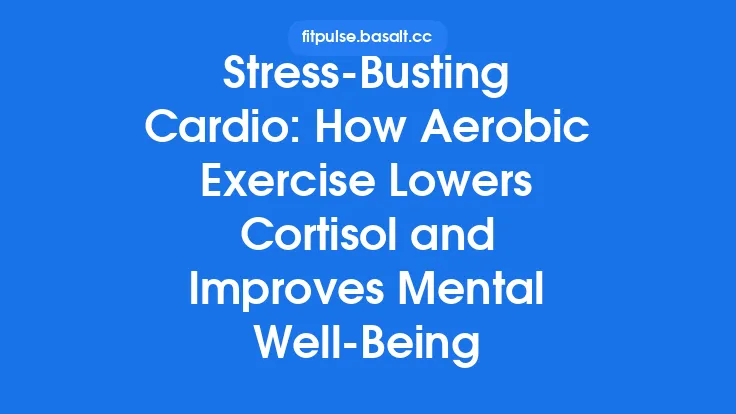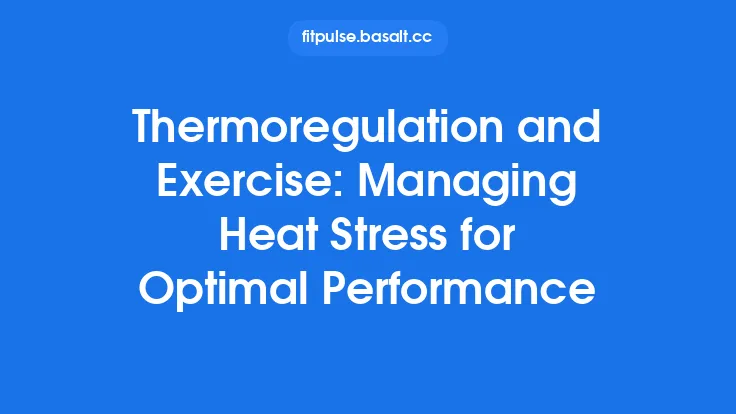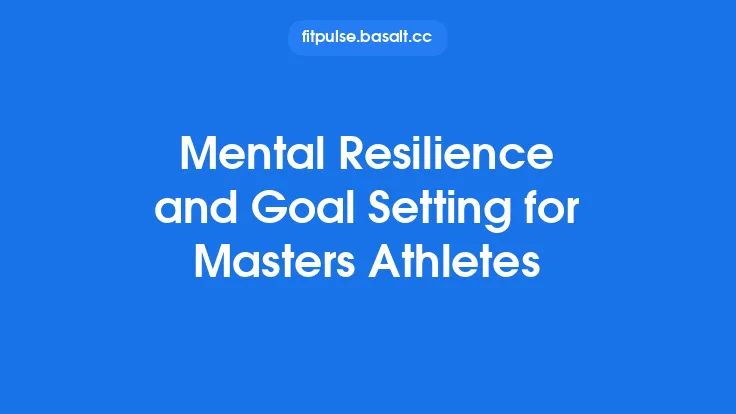Exercise has long been recognized as a cornerstone of physical well‑being, yet its capacity to shape mental health and buffer the deleterious effects of stress is equally profound. In an era where chronic psychosocial pressures are ubiquitous—from workplace demands to digital overload—understanding how movement can serve as a preventive and therapeutic tool is essential for clinicians, fitness professionals, and anyone seeking a resilient mind‑body equilibrium. This article delves into the mechanisms by which exercise modulates stress physiology, outlines evidence‑based modalities, and provides a practical framework for integrating movement into mental‑health‑focused interventions.
Understanding Stress and Its Physiological Pathways
Stress is not merely a psychological state; it is a complex, multi‑system response orchestrated by the central nervous system (CNS) and peripheral effectors. Two primary axes dominate the stress response:
- Hypothalamic‑Pituitary‑Adrenal (HPA) Axis – Activation begins with the perception of a stressor, prompting the hypothalamus to release corticotropin‑releasing hormone (CRH). CRH stimulates the anterior pituitary to secrete adrenocorticotropic hormone (ACTH), which in turn drives the adrenal cortex to produce cortisol. While cortisol mobilizes energy reserves, chronic elevation can impair hippocampal function, disrupt sleep, and promote anxiety‑like behaviors.
- Sympathetic‑Adrenal‑Medullary (SAM) System – Acute stress triggers sympathetic outflow, releasing catecholamines (epinephrine and norepinephrine) that increase heart rate, blood pressure, and glucose availability. Persistent sympathetic dominance contributes to heightened arousal, irritability, and reduced parasympathetic (vagal) tone.
Beyond these axes, stress influences neuroinflammatory pathways, oxidative stress markers, and neurotrophic factors such as brain‑derived neurotrophic factor (BDNF). The interplay among these systems determines whether an individual’s stress response remains adaptive (eustress) or becomes maladaptive (distress).
How Exercise Interacts with Stress‑Related Systems
Physical activity exerts a bidirectional influence on the HPA and SAM axes, essentially “re‑training” the body’s stress circuitry.
| Mechanism | Exercise‑Induced Effect | Implication for Stress Management |
|---|---|---|
| Cortisol Regulation | Acute bouts raise cortisol modestly, but regular training attenuates basal cortisol levels and blunts the cortisol response to subsequent stressors. | Reduces chronic hypercortisolemia, protecting hippocampal integrity and mood stability. |
| Catecholamine Balance | Repeated aerobic sessions enhance norepinephrine reuptake efficiency and increase β‑adrenergic receptor sensitivity, leading to more rapid sympathetic deactivation post‑stress. | Improves recovery from acute stress spikes, lowering perceived tension. |
| Autonomic Modulation | Endurance training elevates heart‑rate variability (HRV), a proxy for vagal tone, indicating stronger parasympathetic control. | Higher HRV correlates with better emotional regulation and resilience. |
| Neurotrophic Support | Both aerobic and resistance exercise up‑regulate BDNF, IGF‑1, and VEGF, fostering neurogenesis and synaptic plasticity, especially in the prefrontal cortex and hippocampus. | Enhances cognitive flexibility and buffers against stress‑induced atrophy. |
| Endocannabinoid Release | Moderate‑intensity activity stimulates anandamide and 2‑AG production, which interact with CB1 receptors to produce anxiolytic effects. | Provides a rapid, non‑pharmacologic anxiolytic pathway. |
| GABAergic Enhancement | Exercise increases GABA synthesis and receptor expression, augmenting inhibitory neurotransmission. | Lowers neuronal excitability associated with anxiety and hyperarousal. |
Collectively, these adaptations shift the stress response curve downward, allowing individuals to experience the same external demands with a reduced physiological load.
Evidence‑Based Exercise Modalities for Stress Reduction
Research across clinical and community settings has identified several exercise formats that consistently demonstrate stress‑mitigating benefits. While the “science behind exercise‑induced mood enhancement” is a distinct domain, the following modalities are selected for their specific relevance to stress physiology and mental‑health promotion.
1. Aerobic Endurance Training
- Typical Prescription: 30–45 minutes of continuous activity at 60–75 % of maximal heart rate (MHR), 3–5 days per week.
- Stress‑Related Outcomes: Decreased basal cortisol, increased HRV, improved sleep architecture, and reduced perceived stress scores (e.g., Perceived Stress Scale, PSS).
- Mechanistic Highlights: Sustained cardiovascular demand promotes mitochondrial biogenesis, which in turn reduces oxidative stress—a contributor to HPA dysregulation.
2. High‑Intensity Interval Training (HIIT)
- Typical Prescription: 4–6 cycles of 30‑seconds “all‑out” effort followed by 1–2 minutes of active recovery, total session ≤20 minutes, 2–3 times weekly.
- Stress‑Related Outcomes: Acute spikes in catecholamines are followed by a pronounced post‑exercise parasympathetic rebound, enhancing HRV more efficiently than moderate‑intensity continuous training.
- Mechanistic Highlights: The intermittent nature stimulates rapid BDNF surges and endocannabinoid release, supporting acute anxiolysis.
3. Resistance (Strength) Training
- Typical Prescription: 2–4 sets of 8–12 repetitions at 70–80 % of one‑repetition maximum (1RM), targeting major muscle groups, 2–3 times weekly.
- Stress‑Related Outcomes: Lowered resting cortisol, increased muscular tension‑release capacity, and heightened self‑efficacy—an important psychological buffer against stress.
- Mechanistic Highlights: Mechanical loading triggers IGF‑1 production, which synergizes with BDNF to support neuroplasticity.
4. Mind‑Body Movement Practices (e.g., Yoga, Tai Chi, Qigong)
- Typical Prescription: 45–60 minutes of flow‑based sequences integrating breath control, proprioceptive focus, and low‑to‑moderate movement, 2–4 times weekly.
- Stress‑Related Outcomes: Significant reductions in salivary cortisol, increased vagal tone, and improved subjective stress resilience.
- Mechanistic Highlights: Breath‑synchronization activates the vagus nerve, directly modulating the SAM system and fostering a state of “rest‑and‑digest.”
5. Outdoor/Green‑Space Exercise
- Typical Prescription: Any of the above modalities performed in natural environments (parks, trails) for ≥20 minutes per session.
- Stress‑Related Outcomes: Synergistic reductions in cortisol and perceived stress beyond indoor equivalents, likely mediated by phytoncides and visual exposure to nature.
- Mechanistic Highlights: Interaction with natural stimuli reduces amygdala activation, attenuating the threat appraisal component of stress.
Prescribing Exercise for Mental Health: FITT Considerations
A structured approach using the FITT (Frequency, Intensity, Time, Type) framework ensures that exercise prescriptions are both physiologically effective and psychologically sustainable.
| Component | Guideline for Stress Management | Rationale |
|---|---|---|
| Frequency | 3–5 sessions per week (minimum 3) | Regular exposure maintains HPA axis adaptation and reinforces autonomic balance. |
| Intensity | Moderate (40–60 % VO₂max) for most individuals; HIIT (≥85 % VO₂max) for those with adequate baseline fitness. | Moderate intensity optimizes cortisol reduction without over‑taxing the SAM system; HIIT provides rapid autonomic rebound for time‑constrained clients. |
| Time | 30–60 minutes per session; HIIT can be ≤20 minutes. | Sufficient duration is needed to trigger neurotrophic cascades; shorter HIIT sessions accommodate busy schedules while still delivering benefits. |
| Type | Combination of aerobic, resistance, and mind‑body modalities. | Multi‑modal training addresses diverse physiological pathways (cardiovascular, musculoskeletal, neurochemical). |
| Progression | Incremental increases of 5–10 % in volume or intensity every 2–3 weeks, contingent on subjective stress levels and recovery markers (e.g., HRV, sleep quality). | Gradual progression prevents over‑recruitment of the stress response and supports sustained adherence. |
Individualization Tips
- Baseline Assessment: Use validated tools such as the PSS, State‑Trait Anxiety Inventory (STAI), and resting HRV to gauge initial stress load.
- Medical Screening: While safety guidelines are beyond this article’s scope, a brief health questionnaire (e.g., PAR‑Q) is advisable to rule out contraindications.
- Psychosocial Context: Consider life stressors, occupational demands, and personal preferences; aligning exercise type with enjoyment enhances adherence and stress‑buffering effects.
Special Populations and Tailored Approaches
1. Individuals with Anxiety Disorders
- Preferred Modalities: Low‑to‑moderate aerobic activity combined with mind‑body practices. HIIT may be introduced gradually to avoid exacerbating hyperarousal.
- Key Adjustments: Emphasize predictable routines, incorporate breathing techniques, and monitor for panic‑type symptoms during high‑intensity intervals.
2. Trauma‑Exposed Populations (e.g., PTSD)
- Preferred Modalities: Structured resistance training and yoga/Tai Chi, which provide a sense of bodily control and grounding.
- Key Adjustments: Offer choice of environment (private vs. group), allow for self‑paced progression, and integrate somatic awareness cues to mitigate dissociation.
3. High‑Stress Occupational Groups (e.g., first responders, healthcare workers)
- Preferred Modalities: Short‑duration HIIT or circuit‑style resistance sessions that can be performed on-site or during shift breaks.
- Key Adjustments: Schedule flexibility, minimal equipment, and inclusion of brief mindfulness or breath‑focus intervals to maximize stress recovery within limited time.
4. Adolescents and Young Adults
- Preferred Modalities: Team‑based aerobic sports, dance, or functional fitness classes that blend social interaction with movement.
- Key Adjustments: Emphasize fun, peer support, and skill development to counteract academic or social stressors.
Integrating Exercise into Therapeutic Regimens
Exercise should be viewed as a complementary modality within a broader mental‑health treatment plan. Collaboration between fitness professionals and mental‑health clinicians enhances outcomes.
- Co‑Referral Pathways
- Clinicians can prescribe “exercise as medicine” using standardized codes (e.g., ICD‑10 Z71.89) and refer patients to qualified exercise specialists.
- Exercise professionals receive brief clinical summaries (stress scores, contraindications) to tailor programs.
- Joint Goal‑Setting
- Align exercise objectives (e.g., “improve HRV by 10 ms over 8 weeks”) with therapeutic goals (e.g., “reduce anxiety severity by one point on the GAD‑7”).
- Use SMART criteria (Specific, Measurable, Achievable, Relevant, Time‑bound) to maintain clarity.
- Session Synchronization
- Schedule exercise sessions shortly after psychotherapy or counseling appointments to capitalize on heightened motivation and to reinforce coping strategies learned in therapy.
- Incorporate “homework” movement tasks (e.g., 10‑minute walk before bedtime) as part of the therapeutic plan.
- Monitoring and Feedback Loops
- Share objective data (HRV trends, activity logs) with the mental‑health provider to adjust medication dosages or therapeutic techniques as needed.
- Use digital platforms (e.g., secure health apps) that allow bidirectional communication while preserving confidentiality.
Monitoring Outcomes and Adjusting Programs
Effective stress‑management through exercise relies on ongoing assessment. The following metrics provide a comprehensive picture:
| Metric | Tool/Method | Frequency | Interpretation |
|---|---|---|---|
| Perceived Stress | Perceived Stress Scale (PSS‑10) | Baseline, every 4–6 weeks | Decline > 5 points indicates meaningful stress reduction. |
| Autonomic Balance | Resting HRV (RMSSD) via chest strap or finger sensor | Weekly (morning, fasting) | ↑ HRV > 10 ms suggests improved vagal tone. |
| Cortisol Rhythm | Salivary cortisol (awakening, 30 min post‑awakening, bedtime) | Baseline, then monthly | Flattened diurnal slope (> 0.2 µg/dL per hour) signals dysregulation; improvement reflects adaptation. |
| Sleep Quality | Pittsburgh Sleep Quality Index (PSQI) or actigraphy | Baseline, every 4 weeks | ↓ PSQI score < 5 denotes good sleep, correlating with stress resilience. |
| Functional Capacity | VO₂max (submaximal test) or 1RM strength test | Baseline, every 8–12 weeks | Increases reflect physiological adaptation, indirectly supporting stress coping. |
| Psychological Symptomatology | GAD‑7, PHQ‑9, or PTSD Checklist (PCL‑5) | Baseline, every 4–6 weeks | Reductions align with mental‑health improvements beyond mood alone. |
When metrics plateau or regress, consider adjusting one or more FITT components, introducing a new modality, or integrating additional recovery strategies (e.g., progressive muscle relaxation, sleep hygiene).
Practical Implementation Strategies for Individuals and Practitioners
- Micro‑Sessions for Busy Lifestyles
- Break the recommended 30‑minute target into three 10‑minute bouts spread across the day (morning walk, lunchtime bodyweight circuit, evening stretching).
- Research shows cumulative micro‑sessions produce comparable cortisol reductions to a single continuous session.
- Environmental Cueing
- Pair exercise with existing daily cues (e.g., “after coffee → 10‑minute walk”).
- Consistent cue‑response patterns reinforce habit formation without relying heavily on formal behavior‑change theory.
- Technology‑Assisted Feedback
- Wearables that display real‑time HRV can alert users when they are in a heightened stress state, prompting a brief “recovery walk” or breathing exercise.
- Data dashboards enable self‑monitoring and empower individuals to see the direct impact of movement on stress markers.
- Social Accountability
- Form “stress‑management squads” where members share weekly activity logs and stress scores, fostering peer support and collective motivation.
- Virtual group classes (e.g., live‑streamed yoga) can provide structure for those lacking in‑person options.
- Recovery Integration
- Schedule at least one low‑intensity recovery day per week (e.g., gentle stretching, foam rolling) to prevent sympathetic over‑activation.
- Incorporate diaphragmatic breathing or progressive relaxation at the end of each session to cement parasympathetic activation.
Future Research Directions and Emerging Technologies
While the evidence base for exercise as a stress‑management tool is robust, several frontiers remain under‑explored:
- Personalized Genomic Profiling: Investigating how polymorphisms in stress‑related genes (e.g., NR3C1 for glucocorticoid receptors) modulate individual responsiveness to specific exercise modalities.
- Neuroimaging Biomarkers: Longitudinal fMRI studies tracking changes in amygdala‑prefrontal connectivity following tailored exercise programs could elucidate neural pathways of stress resilience.
- Artificial Intelligence‑Driven Prescription: Machine‑learning algorithms that integrate HRV, sleep data, and self‑reported stress to generate dynamic, real‑time exercise recommendations.
- Virtual‑Reality (VR) Exercise Environments: Immersive nature‑based VR workouts may replicate the stress‑reduction benefits of outdoor activity for urban dwellers lacking green space.
- Microbiome‑Exercise Interactions: Emerging data suggest gut microbiota alterations from regular physical activity may influence HPA axis regulation, opening avenues for combined probiotic‑exercise interventions.
Continued interdisciplinary collaboration among exercise scientists, psychologists, neuroscientists, and technologists will be pivotal in translating these insights into practical, scalable solutions.
Concluding Thoughts
Exercise stands as a uniquely versatile, low‑cost, and accessible modality for promoting mental health and mitigating stress. By engaging multiple physiological systems—HPA axis modulation, autonomic balance, neurotrophic support, and endocannabinoid activation—regular movement reshapes the body’s response to psychosocial challenges. Practitioners who adopt a structured, evidence‑based FITT framework, tailor programs to individual needs, and integrate exercise within broader therapeutic contexts can empower clients to cultivate resilience, improve emotional regulation, and experience a more balanced, thriving life. The ongoing evolution of research and technology promises ever‑more precise, personalized pathways to harness the full mental‑health potential of physical activity.





